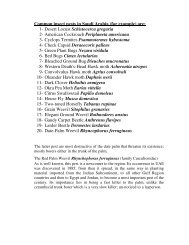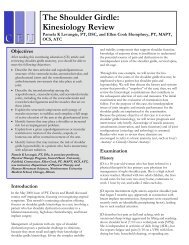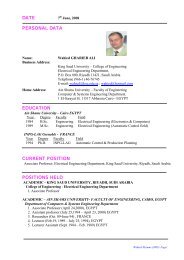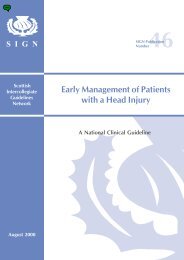INACTIVATION OF TRYPSIN AND CHYMOTRYPSIN INHIBITORS ...
INACTIVATION OF TRYPSIN AND CHYMOTRYPSIN INHIBITORS ...
INACTIVATION OF TRYPSIN AND CHYMOTRYPSIN INHIBITORS ...
Create successful ePaper yourself
Turn your PDF publications into a flip-book with our unique Google optimized e-Paper software.
Res. Bult., No. (130), Food Sci. & Agric. Res. Center, King Saud Univ., pp. (5-17) 2004<br />
<strong>INACTIVATION</strong> <strong>OF</strong> <strong>TRYPSIN</strong> <strong>AND</strong><br />
CHYMO<strong>TRYPSIN</strong> <strong>INHIBITORS</strong> IN FENUGREEK<br />
(Trigonella foenumgraecum L.) DEFATTED<br />
SEED FLOUR<br />
Salah A. Al-Maiman<br />
ABSTRACT<br />
Trigonella foenumgraecum L. defatted flour was assayed for<br />
trypsin and α-chymotrypsin inhibitor activites. The trypsin and αchymotrypsin<br />
inhibitors activities of fenugreek were 45.84 and 7.16<br />
unit/mg protein, respectively. Heating the extract in autoclave (120 C)<br />
for 80 min destroyed 53% of the trypsin inhibitor activity, whereas<br />
only 20 % of the activity of this inhibitor destroyed by microwave<br />
conventional heating for 8 min.<br />
α-Chymotrypsin inhibitor activity in fenugreek defatted flours<br />
was much more heat labile compared to trypsin inhibitors activity.<br />
Autoclave (for 100 min) and microwave (8 min) heating inactivated<br />
30% and 100% of α-chymotrypsin inhibitors activity, respectively.<br />
Key words: Trypsin, chymotrypsin, fenugreek, inhibitors, autoclave,<br />
microwave.<br />
_____________________________________________________________<br />
Dept. of Food Science and Nutrition, College of Food Sciences and Agriculture,<br />
King Saud University, P.O. Box 2460, Riyadh 11451, Saudi Arabia<br />
Email: smaiman@ksu.edu.sa<br />
- 5 -
INTRODUCTION<br />
Fenugreek (Trigonella foenumgraecum), one of many<br />
condiments known to mankind, has been cultivated for a very long<br />
time. It has been popularly used in western Asia, northern India,<br />
Africa and Mediterranean region as a food and medicine. The foliage<br />
of fenugreek is commonly eaten as leafy vegetable. Its powder is<br />
considered a good antiseptic and employed for improving skin texture.<br />
Seeds of fenugreek are being consumed to facilitate lactation also.<br />
The nutritional importance of food legumes as an economic<br />
source of proteins has been recognized throughout the world, It<br />
contains 26.2% protein, 5.8% fat and 44.1 % carbohydrate. (Patil et al.<br />
1997.; Borget, 1992 and Geil and Anderson,1994 ). Consuming grain<br />
legumes is more economically directed instead of converting them<br />
into animal proteins. Legumes have been considered as leading<br />
candidates in protein supply to the malnourished areas of the world<br />
(Gent, 1994, Muehlbauer and Kaiser, 1994 and Oram and Agcaoili,<br />
1994). Certain antinutritional factors, which negatively affected<br />
protein digestibility have been reported as proteinase inhibitors<br />
especially trypsin and α-chymotrypsin inhibitors (El-Mahdyl,1981 and<br />
Ismail et al.1995) . These inhibitors stimulate pancreatic juice<br />
secretion and cause pancreatic hypertrophy and growth inhibition<br />
(Liener and Kakade 1980).<br />
Legume proteins are difficult to digest because of the presence<br />
of trypsin inhibitors (Mossor et al.1984). These naturally occurring<br />
proteins have the property of combining with and inactivating trypsin<br />
(Wilson, 1981).<br />
Removal of the undesirable components from the dry legume<br />
seeds is essential for improving their nutritional qualities. To achieve<br />
this, several processing methods such as germination, soaking and<br />
cooking have been used (Ismail et al.1995 and Barampama and Simart<br />
1994). Furthermore, non conventional method such as the use of<br />
microwave heating (Sakla et al., 1988; Snyder et al.1991; and Sakac et<br />
al. 1996) and Irradiation (Ghazy et al. 1992 and Abu-Tarboush 1998)<br />
have been investigated. Rajko et al. (1997) investigated the role of<br />
microwave energy in reducing enzyme activity in whole soybeans.<br />
- 6 -
He indicated that, the characteristic feature of microwave heat is that<br />
it ensures homogeneous operation in whole volumes of substance,<br />
great penetrating depth, and selective absorption. The objective of this<br />
study was to inactivate of trypsin and α-chymotrypsin inhibitors in<br />
fenugreek seeds by autoclave and conventional microwave heating.<br />
Material<br />
MATERIALS <strong>AND</strong> METHODS<br />
Fenugreek seeds were brought from the local market in<br />
Algasseem area, 330 Km North West of Riyadh, Saudi Arabia. Seeds<br />
were milled to pass through a 0.355 mm sieve, using an ultracentrifugal<br />
mill (Resh type 2MI, F., Kurt Retsh GmbH and Co.,<br />
Germany).<br />
Sample Defatting<br />
El-Tinay et al., (1988) method was used for the defatting of<br />
fenugreek seeds. Sample was mixed with n-hexane (1:10 w/v) and<br />
stirred for 2 hrs at room temperature, and then the mixture was left<br />
overnight. In the next day, the mixture was filtered and the residue<br />
was collected and dried for 12 hrs at room temperature. The process<br />
was repeated two more times to extract the complete oil from the<br />
sample. After milling and sieving (60 mesh), the defatted fenugreek<br />
flour was kept in the refrigerator for further analysis.<br />
Treatments<br />
Samples were placed in autoclavable Petri dishes in one layer<br />
then autoclaved (autoclave model No. TV30UL, Memmert, Germany)<br />
and microwaved (microwave Model No. R-9H56 with an output<br />
power of 850 W and a frequency of 2450 MHz equipped with<br />
temperature sensor, Sharp Corp., Japan) at 120°C and 130°C,<br />
respectively for different times ( 0, 20, 40, 80 and 100 min. for the<br />
autoclave treatment and 0, 2, 4, 8 and 10 min. for the microwave<br />
treatments).<br />
- 7 -
Trypsin Inhibitor Activity Assay of Fenugreek<br />
Trypsin inhibitor activity determination of autoclaved and<br />
microwaved fenugreek of defatted flour was conducted according to<br />
the method of Kakade et al. (1969) using Nα-benzoyl-DL-arginine pnitroanilide<br />
(Sigma Chemical Co., St. Louis, MO) at a concentration<br />
of 30 mg/100 mL as a synthetic substrate. One gram of the defatted<br />
flour was extracted with 15 mL of citrate buffer (pH 4.6), stirred for 2<br />
h at room temperature (25 °C), and then centrifuged at 4500 rpm for<br />
20 min. The reaction mixture consisted of 0.1 mL of the extract, 0.9<br />
mL of distilled water, 7 mL of the synthetic substrate, and 1 mL of<br />
trypsin type III (Sigma). Trypsin type III from bovine pancreas at<br />
concentration of 4 mg/100 mL of 0.001 M HCI was used in the<br />
reaction mixture. The absorbance was recorded at 410 nm, and the<br />
inhibitor activity was calculated using a control sample of trypsin.<br />
α-Α-chymotrypsin Inhibitor Activity Assay of Fenugreek<br />
The method of Kakade et al. (1970) was employed for<br />
determining α-chymotrypsin inhibitor activity using bovine pancreas,<br />
type II α-chymotrypsin (Sigma), and 1% casein (BDH Chemicals,<br />
Poole, U.K.) as substrate. One α-chymotrypsin unit (CU) was<br />
arbitrarily defined as an increase of 0.01 absorbance unit at conditions<br />
described in this method, and the α-chymotrypsin Inhibitor activity<br />
was defined as the number of α-chymotrypsin units inhibited (CUI).<br />
Statistical Analysis<br />
Data from three replications for each time treatment<br />
combinations were analyzed using analysis of variance and Fisher<br />
LSD of the SAS program (Statistical Analysis Systems Institutes,<br />
1995).<br />
RESULTS <strong>AND</strong> DISCUSSION<br />
Trypsin inhibitor activity in fenugreek defatted seed flour was<br />
45.84 units/mg protein (table 1). This value is considered to be high if<br />
compared to 26 unit/mg protein of defatted soy protein (Al-Kahtani<br />
1995). Also it is higher than karkade defatted seed flour which was 41<br />
- 8 -
Table 1. Effect 1 of autoclave (120°C) and microwave(130°C)<br />
heating on trypsin and α-chymotrypsin inhibitors of<br />
fenugreek (Trigonella foenumgraecum L.) defatted seed<br />
flour.<br />
Autoclave<br />
(120°)<br />
Treatment<br />
(min)<br />
Microwave<br />
(130°)<br />
0 0<br />
20 2<br />
40 4<br />
60 6<br />
80 8<br />
100 10<br />
Trypsin Inhibitor<br />
( unit /mg protein) 2<br />
Autoclave<br />
45.84 a<br />
± 0.44<br />
35.46 b<br />
± 0.35<br />
33.56 b<br />
±1.49<br />
30.40 c<br />
±0.27<br />
23.92 d<br />
±2.73<br />
22.28 d<br />
±0.93<br />
- 9 -<br />
Microwave<br />
45.84 a<br />
±0.44<br />
45.71 a<br />
±0.29<br />
45.10 a<br />
±0.70<br />
38.47 b<br />
±1.44<br />
37.27 b<br />
±0.65<br />
37.02 b<br />
±1.11<br />
1 Means ± SD (n=3) means in column with unlike superscripts differ significantly (P≤ 0.05).<br />
α-Chymotrypsin<br />
inhbitor<br />
( unit / mg protein)<br />
Autoclave<br />
7.16 a<br />
±0.35<br />
3.24 b<br />
±0.16<br />
2.77b c<br />
±0.22<br />
2.60 c<br />
±0.08<br />
2.47 cd<br />
±0.05<br />
2.03 d<br />
±0.12<br />
Microwave<br />
7.16 a<br />
±.0.35<br />
2.16 b<br />
±0.20<br />
1.18 c<br />
±0.04<br />
0.98 c<br />
±0.15<br />
0 d<br />
±0.00<br />
0 d<br />
±0.00<br />
2 One unit of trypsin and α-chymotrypsin inhibitory was defined as that which reduces the activity of trypsin and α-chymotrypsin<br />
by one unit.
unit/mg protein (Abu Traboush and Ahmad 1996). On the other<br />
hand, the trypsin inhibitor value obtained in this study was lower than<br />
that of the different defatted soy protein products which ranged from<br />
60.8 to 107.5 unit/mg (Kakade et al. 1969). These differences in the<br />
activity of trypsin inhibitor in the different studies of defatted soy<br />
protein flour might be due to different chemical used like buffer that<br />
have been used for extraction, substrate, type of seeds as well as<br />
environmental factors (Ikeda and Kussano, 1983). El-Morsi et al.<br />
(1991) were able to decrease trypsin inhibitor in fenugreek seeds by<br />
up to 84% using germination for 120 huors. Al-Housein and Abu-<br />
Tarboush (1997) reported that using BAPA as a substrate could<br />
increase the trypsin inhibitor activity values by 25-30% compared to<br />
using casein as a substrate. Inactivation of trypsin inhibitor activity<br />
has been attributed to the destruction of disulfides amino group which<br />
could have been affected by radiation (Lee, 1962 ).<br />
El Morsi, 1982 has reported the inactivation of trypsin<br />
inhibitors which could also be due to the destruction of lysine.<br />
Fenugreek defatted seed flour contained around 7.16 unit/ mg protein<br />
α-chymotrypsin inhibitor activity. This value is lower than that<br />
reported for defatted soy protein flour (57.20 unit/mg protein) and<br />
karkade defatted seed flour (21.8 unit/mg protein). However, it was<br />
was higher than that reported by Al-Housein and Abu-Tarboush<br />
(1997) for Al-Ban (Al-Yassar) seed protein.<br />
Table 1 and figures 1 and 2 show the effect of autoclave and<br />
microwave heating on fenugreek defatted flour. Activity of trypsin<br />
inhibitor decreased as the heat-time for autoclave increased. Although<br />
autoclave heating for 100 min caused more destruction of trypsin<br />
inhibitor (55%) compared to 80 min heating by autoclave (53%), the<br />
difference in destruction was not significant (table 1 and Figure 1).<br />
The extracts of defatted flour, protein concentrate, and protein isolate<br />
of soybean (Moringa peregrina), when boiled for 5 hrs at 95°C<br />
retained 18.5% and 9.3% of the original trypsin inhibitor activities,<br />
respectively (Al-Kahtani,1995). Koeppe et al. (1985) found that 20<br />
% of the original amaranth trypsin inhibitor activity remained at the<br />
end of 7 hrs heating at 100° C. It seems that trypsin inhibitor of fenugreek<br />
is more resistant to heat than the trypsin inhibitor in Moringa<br />
peregrine and amaranth.<br />
- 10 -
Activity (%)<br />
100<br />
80<br />
60<br />
40<br />
20<br />
0<br />
1 2 3 4 5 6<br />
Treatment<br />
Figure-1: Trypsin inhibitor activity (%) after treatment with<br />
microwave (130° C) and autoclave(120 °C) heating with<br />
treatment 1= no heating; 2= 20 min autoclave and 2 min<br />
microwave;3=40 min autoclave and 4 min microwave;<br />
4=60 min autoclave and 6 min microwave; 5=80 min<br />
autoclave and 8 min microwave and 6=100 min autoclave<br />
and 10 minute microwave.<br />
- 11 -<br />
Autoclave<br />
Microwave
Activity (%)<br />
100<br />
80<br />
60<br />
40<br />
20<br />
0<br />
1 2 3 4 5 6<br />
Treatment<br />
Figure-2. α-Chymotrypsin inhibitor activity (%) after treatment with<br />
microwave (130° C) and autoclave(120 °C) heating with<br />
treatment 1= no heating; 2= 20 min autoclave and 2 min<br />
microwave;3=40 min autoclave and 4 min microwave;<br />
4=60 min autoclave and 6 min microwave; 5=80 min<br />
autoclave and 8 min microwave and 6=100 min autoclave<br />
and 10 minute microwave.<br />
- 12 -<br />
Autoclave<br />
microwave
Microwave conventional heating had less effect on trypsin<br />
inhibitor of fenugreek compared to autoclave heating (Table 1).<br />
Destruction of trypsin inhibitor of fenugreek defatted flour by<br />
microwave increased by time; however significant effect was noticed<br />
only after 6 min of heating. At this time, heating time only only 20 %<br />
of the trypsin inhibitor was destroyed (Figure 1).<br />
α-Chymotrypsin inhibitor activity of fenugreek defatted flour<br />
was less (7.16 units/ mg protein) than that of the trypsin inhibitor<br />
activity (Table 1). This results agreed with the finding of Singh and<br />
Jambunathan (1981) reported considerable differences in the levels of<br />
trypsin and α-chymotrypsin inhibitors between two chickpea cultivars.<br />
Abu-Tarboush and Ahmed (1996) reported also higher trypsin<br />
inhibitor activities in karkade and soybean defatted flour than their αchymotrypsin<br />
inhibitor.<br />
Autoclave treatment reduced α-chymotrypsin inhibitor activity<br />
in fenugreek defatted flour and destruction increased significantly<br />
with the increase of heating time. However, no significant differences<br />
were noticed among the heating times of 40, 60 and 80 min (Table 1).<br />
The α-chymotrypsin inhibitor activity retained about 30 % of its<br />
original activity after heating for 100 min (Figure 2). The gradual loss<br />
in inhibitory activity of α-chymotrypsin was achieved by microwave<br />
conventional heating with time (Table 1).<br />
α-Chymotrypsin inhibitor activity inactivated completely by heating<br />
with microwave after 8 min (Table 1 and Figure 2). The αchymotrypsin<br />
inhibitor of fenugreek was more heat labile than trypsin<br />
inhibitor and microwave conventional heating was more effective than<br />
autoclave in inactivating the α-chymotrypsin inhibitor. Rajko et al.<br />
(1997) mentioned that the use of microwave energy is more efficient<br />
than the traditional heating treatment. They also added that the<br />
characteristics feature of microwave heat is that it ensures<br />
homogeneous operation in whole volume of substance, great<br />
penetrating depth, and selective absorption.<br />
- 13 -
REFERENCES<br />
Patil, S. P.; Niphadkar, P. V. and Baqat, M. M. (1997). Allergy to<br />
Fenugrek (Trigonella foenum graecum). Annals of Allergy,<br />
Asthma and Immunology. Sir Hurkisondas Nurrotumdas<br />
Medical Res. Soc. Bombay, India. 297-300.<br />
Borget, M. (1992) Food Legumes, MacMillan, London.<br />
Geil, P. B. and Anderson, J. W. (1994). Nutrition and health<br />
implications of dry beans: a review. J. Am. Coll. Nutr. 13: 549-<br />
558.<br />
Gent, G. P. (1994). Policy incentives for expanding European pulse<br />
production. Cur. Plant Sci. Biotechnol. Agric. 19: 361-366.<br />
Muehlbauer, F. J. and Kaiser, W. J. (1994). International Food<br />
Leaume Research Conference on Pea, Lentil, Faba Bean,<br />
Chickpea and Grasspea. Kluwer Academic, Boston.<br />
Oram. P. A. and Agcaoili, M. (1994). Current status and future trends<br />
in supply and demand of cool season food legumes. Curr. Plant<br />
Sci. Biotechnol. Agric. 19 : 3-49.<br />
El-Mahdy, A. R.; Moustafa, E.K. and Mohamaed, M. S. (1981).<br />
Trypsin inhibitor activity in Vicia faba, Food Chem., 7: 63-71.<br />
Ismail, H. A.; Abo El-Fetouh, S.A.; Zaki, A.M.; Shakankery, M.M.<br />
and El-Morsi, E.A. (1995). Purification and Characterization of<br />
trypsin/chymotrypsin inhibitor from seeds of field bean (Vicia<br />
faba L.). J. Agric. Sci., Mansoura Univ., 20: 3922-3940.<br />
Liener, I.E. and Kakade, M.L. (1980). Protease inhibitors in: Toxic<br />
constituents of plant foodstuffs, 2 nd ed.; Liener, I.E., ed.;<br />
Academic Press, New York.<br />
Mossor, G., Skupin, J. and Romanowska, B. (1984). Plant inhibitors<br />
of proteolytic enzymes. Nahrung 28 : 93-112.<br />
- 14 -
Wilson, K. A. (1981). The structure, function and evolution of<br />
legume proteinase inhibitors. In Antinutrients and Natural<br />
Toxicants in Foods (R. L. Ory, Ed.), pp. 187-202. Food and<br />
Nutrition Press, Westport, CT.<br />
Barampama, Z. and Simart, R.E. (1994). Oligosaccharides,<br />
Antinutritional factors and protein digestability of dry beans as<br />
affected by processing. J. Food Sci., 59: 833-838.<br />
Sakla, A. B.; Ghali, Y.; El Farra, A. and Rizk, L. F. (1988). The effect<br />
of environmental conditions on the chemical composition of<br />
soybean seeds: deactivation of trypsin inhibitor and effect of<br />
microwave on some components of soybean seeds. Food Chem.,<br />
29 : 269-274.<br />
Snyder, J. M.; Mounts, T. L. and Holloway, R. K. (1991). Volatiles<br />
from microwave-treated, stored soybeans. J. Am. Oil Chem.<br />
Soc., 68 : 744-747.<br />
Sakac, M.; Ristic, M. and Levic, J. (1996). Effects of microwave<br />
heating on the chemico nutritional value of soybeans. Acta<br />
Aliment., 25 : 163-169.<br />
Ghazy, M.A.; Abdel-Salam, H.S.; Aboul-Fetouh, S.A.; Ismail, H.A.<br />
and Fawzy, AM. (1992). Effect of gamma-irradiation on soluble<br />
sugars and raffinose oligosaccharides in field bean (Vicia faba<br />
L.) seeds during germination. Minia J. Agric. Res. & Dev.,<br />
14:873-896.<br />
Abu-Tarboush, H.M. (1998). Irradiation Inactivation of Some<br />
Antinutritional Factors in Plant Seeds. J. Agic. Food Chem.,<br />
46:2698-2702.<br />
Rajko, R.; Szabo, G.; Vidal-Valverde, C. amd Kovacs, E. (1997).<br />
Designed Experiments for Reducing Antinutritive Agents in<br />
Soybean by Microwave Energy. J. Agric. Food. Chem. 45:<br />
3565-3569<br />
- 15 -
El-Tinay, A. H.; Nour, A. H.; Abdel-Karin, S. H. and Mahgoub, S.<br />
O. (1988) Aqueous protein and Gossypol Extraction from<br />
Glanded Cottonseed Flour: Factors Affecting Protein Extraction.<br />
Food Chem., 29: 57-63.<br />
Kakade, M. L.; Simsons, N. and Liener, I. E. (1969). An Evaluation<br />
of Natural vs. Synthetic Substrates for Measuring the Antitryptic<br />
Activity of Soybean Samples. Cereal Chem., 49 :518-526.<br />
Kakade, M.L.; Swnson; D.H. and Liener, I.E. (1970). Note on The<br />
Determination of Chymotrypsin and Chymotrypsin inhibitor<br />
Activity Using Casein. Anal. Biochem., 33 : 255-258.<br />
SAS (1995) SAS User's Guide, Statistics. Cary-N.C, SAS Institute<br />
Inc.<br />
Al-Kahtani, H. A.(1995). Some Antinutritional Factors in Moringa<br />
peregrina (Al-Yassar or Al-Ban) and Soybean products. J. Food<br />
Sci., 60 : 395-398.<br />
Abu-Tarboush, H.M. and Ahmed, S.B.(1996). Studies on Karkade<br />
(Hibiscus sabdariffa): Protease Inhibitors, Phytate, in vitro<br />
Protein Digestability and Gossypol Content. Food Chem., 56<br />
:15-19.<br />
Ikeda, K. and Kussano, T. (1983). In vitro inhibition of digestive<br />
enzymes by indigestible polysaccharides. Cereal Chem. 60 :<br />
260-263.<br />
El-Morsi, E. A.; Issa, M. A.; Abdel-Salam, H.S. and Hussein, M. Y.<br />
(1991). Influence of germination on raffinose oligosaccharides<br />
and trypsin inhibitor in fenugreek. Minia J. Agric. Res. Dev. 13:<br />
1523-1540.<br />
Al-Housein, A.A. and Abu-Tarboush, H.M. (1997). Nutritional Value<br />
and Thermal Stability of Trypsin and Chymotrypsin Inhibitors<br />
in Al-Ban (Al-Yassar) Seed Protein (Moringa peregrina). J.<br />
King Saud Univ., 9 : 187-208.<br />
- 16 -
Lee, C.C. (1962). Electronic para magnetic resonance (ESR) and<br />
backing studies on gamma-irradiation flour. Cereal Chem. 39:<br />
147-153.<br />
El-Morsi, E. A. (1982). Solubility and gel filtration chromatography<br />
of water extractable field bean proteins. Annals Agric. Sci., 27:<br />
23-36.<br />
Koeppe, S.; Rupnow, J. H.; Walker, C. E. and Davis, A. (1985).<br />
Isolation and heat stability of trypsin inhibitors in amaranth<br />
(Amaranthus hypochondriacus). J. Food Sci. 50: 1519-1521.<br />
Singh, U. and Jambunathan, R. (1981). Studies on desi and kabuli<br />
chickpea (Cicer arietinum L.) cultivars: Levels of protease<br />
inhibitors, levels of polyphenolic compounds and in vitro<br />
protein digestibility. J. Food Sci. 46: 1364-1367.<br />
- 17 -
( -)<br />
<br />
(<br />
)<br />
- 18 -<br />
<br />
<br />
(Trigonella foenumgraecum)<br />
<br />
<br />
<br />
<br />
<br />
<br />
. <br />
. (Ttigonella foenumgraecum)<br />
% ( ° )<br />
<br />
/ , , <br />
<br />
% <br />
<br />
° <br />
. <br />
) % <br />
( ° )<br />
% ( <br />
. <br />
________________________________________________________<br />
.<br />
<br />
<br />
<br />
.


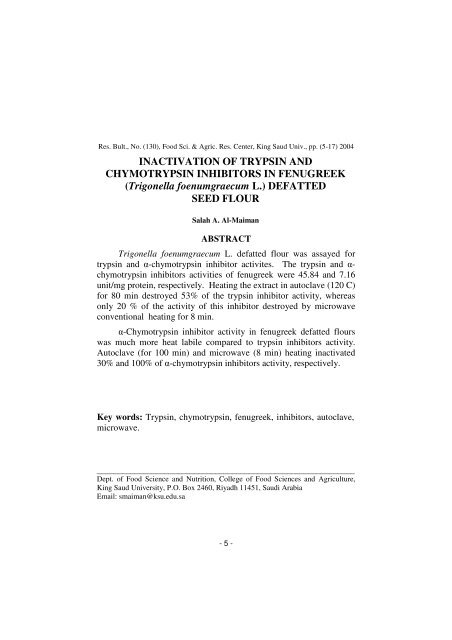
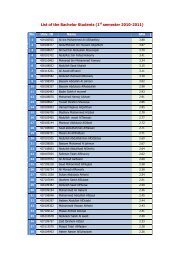
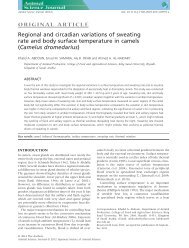
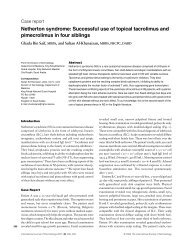
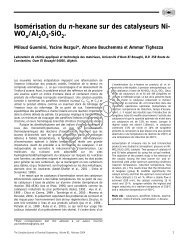
![التجربية الأولي [Read-Only] - KSU](https://img.yumpu.com/15502211/1/190x135/-read-only-ksu.jpg?quality=85)
